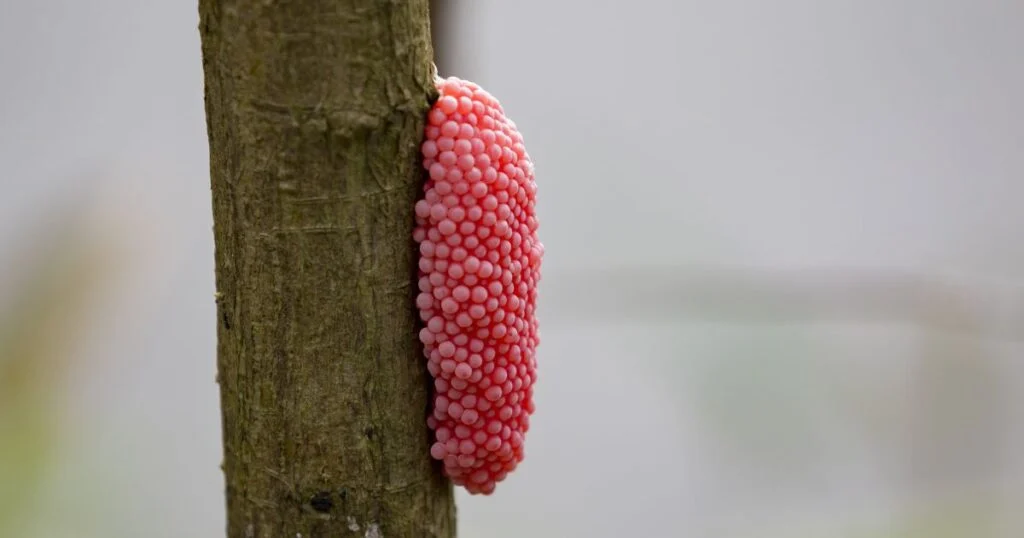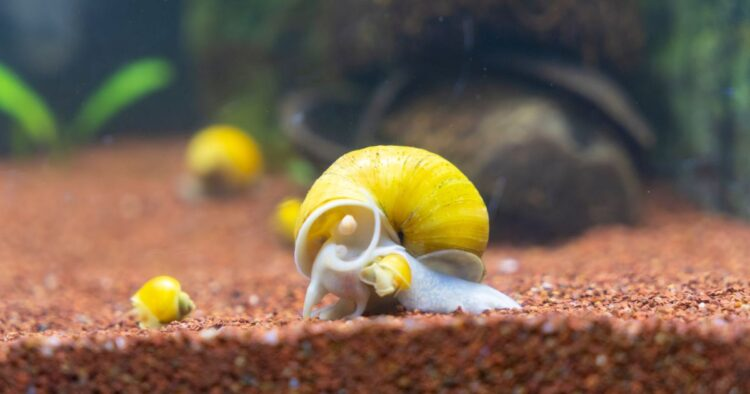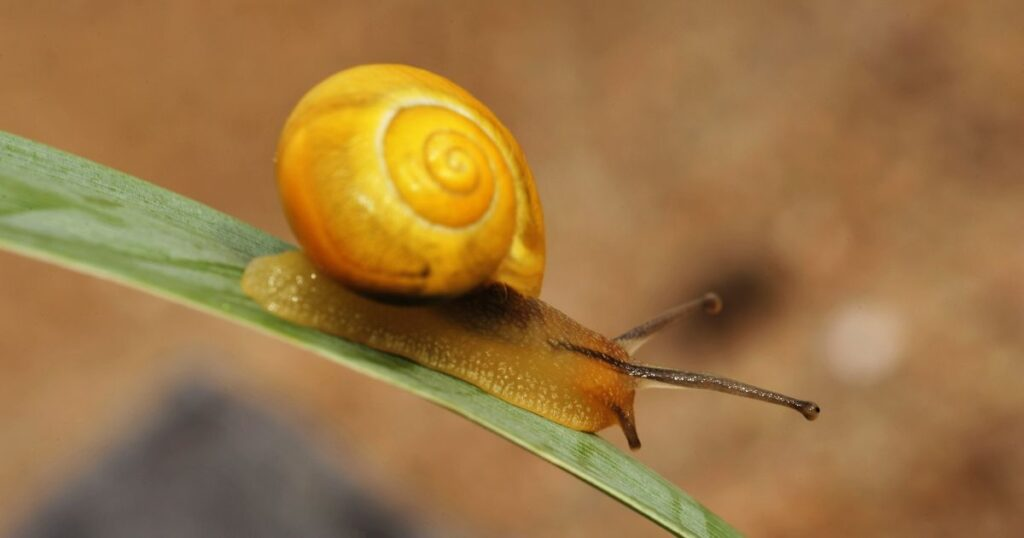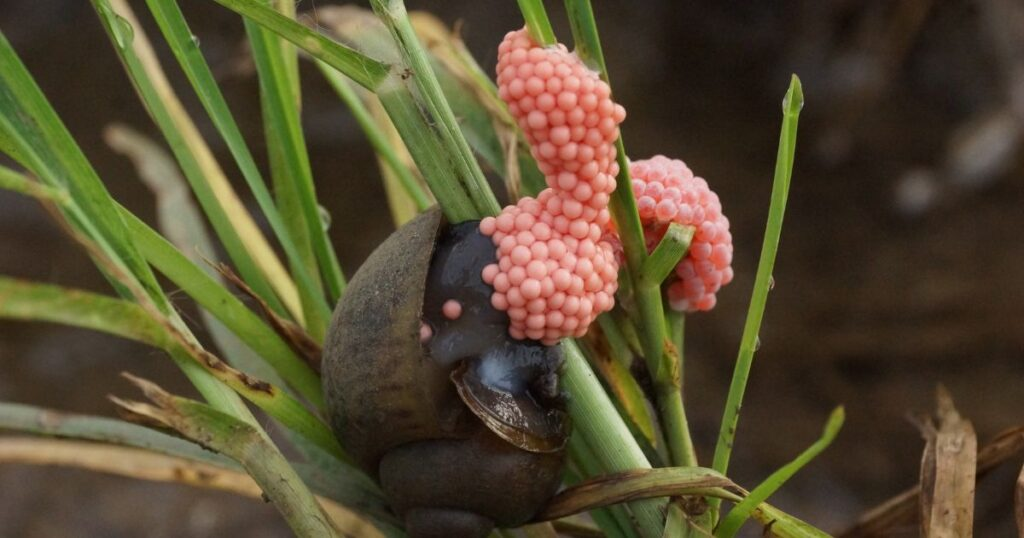As you stroll through your garden, you may spot clusters of tiny pink eggs dotting the landscape, particularly near water sources. They may seem harmless, even charming, but these vibrant pink eggs are actually a warning sign of a serious ecological threat—the invasion of the apple snail. Known for their destructive impact on agriculture and biodiversity, apple snails are much more than a curious sight. In this article, we’ll explore where they come from, the problems they cause, and what we can do to control their spread.
Understanding the Pink Eggs: What Are They?

Those clusters of pink eggs you see aren’t just a quirky decoration in your garden; they’re the eggs of a notorious invasive species known as the apple snail, scientifically referred to as Pomacea canaliculata. Originating in South America, these freshwater snails thrive in marshes, ponds, and wetlands. While the eggs may look intriguing, their presence signals a potential threat to local ecosystems, as apple snails can wreak havoc on natural habitats and agricultural lands alike.
Apple Snails: The Giant Pest with an Insatiable Appetite
When you think of snails, you might imagine small, slow creatures in your garden, but apple snails are a different breed. These massive gastropods can grow up to 10 centimeters in diameter, dwarfing most common garden snails. With their large size comes an equally large appetite. Apple snails are voracious feeders that primarily consume aquatic plants, causing substantial damage to the ecosystems they invade.
Their feeding habits can strip wetlands of vital vegetation, disrupting the balance of freshwater habitats. By eating through the plants that many native species rely on, apple snails not only harm individual plants but can also trigger a chain reaction that affects entire ecosystems.
Rapid Reproduction: Apple Snails and Their Egg Clusters
One of the most alarming aspects of apple snails is their rapid reproduction. A single female can lay between 400 and 600 eggs at a time, often in bright pink clusters just above the waterline. These eggs, which range from two to three millimeters in size, hatch quickly, allowing the snails to spread at an astonishing rate.
This high reproductive potential means that apple snails can establish themselves in new environments within a matter of weeks. Their egg clusters serve as both a warning and a reminder of just how quickly an infestation can grow. Without intervention, a few apple snails can rapidly multiply, leading to a full-scale invasion in ponds, wetlands, and even garden water features.
The Global Spread of the Apple Snail: A Growing Threat

Originally from South America, apple snails have spread across continents, facilitated by human activity, climate change, and their adaptability to various habitats. The story of their spread serves as a cautionary tale about the unintended consequences of introducing non-native species.
Invasion Across Asia and North America
In the 1980s, apple snails were introduced to Asia as a potential food source. However, it didn’t take long for them to escape into the wild, where they began to devastate rice paddies and other crops. Today, apple snails are considered one of the world’s top 100 invasive species, with populations spreading throughout Asia and the southern United States, including Florida, Texas, and the Carolinas.
Europe and the Emergence in France

The apple snail has also made its way to Europe. In 2018, the first sightings were reported in southern France, where the species established itself in local water bodies. In response, France implemented emergency measures to prevent further spread, but the presence of apple snails in Europe is a troubling sign. The species’ adaptability means it could continue to spread, threatening ecosystems across the continent.
Environmental and Agricultural Impact: A Destructive Force
Apple snails pose a serious threat to both the environment and agriculture. Here are the primary ways in which they cause damage:
- Destruction of Aquatic Vegetation: Apple snails consume large amounts of aquatic plants, which are essential for healthy ecosystems. By devouring these plants, they reduce biodiversity and disrupt the natural balance of freshwater habitats.
- Threat to Agriculture: Rice fields are particularly vulnerable to apple snails, as the snails feed on young shoots. In Asia, apple snails have caused significant crop losses, threatening food security in affected regions.
- Impact on Native Species: Apple snails outcompete native species for resources, which can lead to a decline in local snail populations. Their feeding habits also contribute to water quality degradation, as they stir up sediment and increase decomposing plant matter in the water.
Controlling the Spread of Apple Snails

Given the extensive damage apple snails can cause, various control measures have been implemented around the world. These include:
- Manual Collection and Egg Removal: In some areas, apple snails and their eggs are collected manually to limit their spread. Destroying egg clusters before they hatch can help reduce the population over time.
- Biological Control: Some countries are exploring biological control methods, such as introducing natural predators that feed on apple snails. While this can be effective, it must be carefully managed to avoid further ecological disruption.
- Legislative Restrictions: In the United States and Europe, regulations have been put in place to limit the sale and transport of apple snails. This helps prevent accidental introductions to new areas and curbs their spread.
What to Do If You Find Pink Eggs in Your Garden
If you notice clusters of pink eggs in your garden, it’s essential to act quickly. Here’s what you can do:
- Report to Local Authorities: Many environmental agencies have protocols for dealing with invasive species. Reporting sightings can help authorities monitor and control the spread.
- Remove the Eggs Safely: If allowed, carefully scrape the eggs off their surface and place them in a sealed container for disposal. Avoid discarding them in water, as this can contribute to the spread of the snails.
- Monitor for New Clusters: Apple snails reproduce rapidly, so ongoing monitoring is key. Keep an eye out for additional egg clusters, especially near water sources, and take action as needed.
Conclusion: Vigilance Against a Silent Invader
The presence of pink egg clusters may seem harmless, but they signal a much larger threat to biodiversity and agriculture. Apple snails, with their rapid reproduction and destructive feeding habits, are a formidable invasive species capable of causing widespread ecological damage. By staying vigilant and taking action when you encounter pink egg clusters, you can help protect local ecosystems and curb the spread of this invasive snail. Remember, every effort counts in the fight to preserve biodiversity and maintain a balanced environment.


